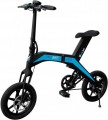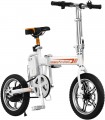Max weight
The maximum load allowed for a bicycle is, in other words, the maximum weight that it can normally carry in normal use. Of course, when calculating the load, the weight of both the cyclist himself and the additional load that he carries with him is taken into account.
The permissible load must definitely not be exceeded: even if the bike does not break down immediately, off-design loads can weaken the structure, and an accident can occur at any time. Also note that it is desirable to have a certain weight margin — at least 15 – 20 kg: this can be useful in case of transporting heavy loads and will give an additional guarantee in emergency situations (for example, when a wheel gets into a pit). Considering that the average weight of an adult is about 70 – 80 kg, bicycles with a permissible load
of up to 100 kg can be classified as "lightweights",
from 100 to 120 kg — to the middle category,
more than 120 kg — to "heavy trucks".
Seatpost suspension
The presence in the design of the bicycle of a separate shock absorber under the saddle.
The seatpost cushioning significantly reduces the vibration and shock felt by the rider, which is especially important when riding on uneven terrain.
Wheel size
The nominal diameter of the bicycle wheels. Usually, this paragraph actually indicates the size of the bicycle tyres supplied in the kit, more precisely, the outer diameter of the tyres.
Wheel diameter is traditionally indicated in inches. For bicycles of different purposes and age groups (see paragraphs above), there are certain size standards. So, adult mountain models are equipped mainly with
26 " wheels, "road" and urban ones — with a slightly larger diameter (mostly
28 "), and BMX for the most part — much smaller; children's and teens' bikes have smaller wheels than similar adults' bikes.
Other things being equal, larger tyres hold speed better and work out small bumps on the road; and relatively small wheels are more “sticky”, they provide more torque and better traction. This is the reason for the above-described difference in wheel sizes between bicycles for different purposes. Such nuances will be useful if you choose a car from several models with similar characteristics, but different wheel diameters. Here it is worth considering the features of the planned application. For example, for urban and "road" driving — on a hard surface without any special irregularities and elevation changes — it is better to choose larger wheels, and for dirt roads with ups and downs — smaller ones.
Also note that tyres are replaceable, and many bikes allow the installation of tyres of
...a “non-native” size — for example, 29 "on a model with 28-inch wheels. It is also worth considering that wheels (tyres) of the same size may differ in inner (landing) diameter These nuances are described in detail in special sources.Alloy wheels
Light-alloy wheels of a monolithic design, cast in special moulds from aluminium, less often from titanium. Bicycles with
alloy wheels are characterized by increased resistance to oncoming air flows, strength and durability, and aesthetic appeal. At the same time, alloy wheels are less resistant to side gusts of wind, have poor maintainability and are very expensive. Alloy wheels are found mainly on board city and road electric bicycles, also specialized racing bike models are equipped with alloy wheels.
Max range
The maximum range of an e-bike (see "Application") is the maximum distance that it can be ridden using the electric motor on a single battery charge.
Usually, the characteristics indicate the range at the most economical way to use the battery: in the pedal assist mode (see "Operating modes") and at a relatively low speed. Accordingly, in fact, this parameter may turn out to be lower than the claimed one, especially if you drive in full electric mode. Nevertheless, in terms of power reserve, it is quite possible to evaluate and compare various models with each other.
Note that it makes sense to specifically look for a model with a power reserve
of more than 50 km if long trips are planned without recharging along the way. For episodic rides, you can pay attention to cars
with less battery life — they are simpler and cheaper.
Battery capacity
The capacity of the battery that the e-bike is equipped with (see "Application"), expressed in ampere-hours.
The battery capacity directly affects the operating time on a charge and, accordingly, the power reserve. However, in fact it hardly makes sense to evaluate these parameters by the number of ampere-hours. Firstly, the actual battery life will depend not only on the characteristics of the battery, but also on the power of the engine (which determines the power consumption of the machine). Secondly, the actual amount of energy stored in the battery depends not only on the capacity in ampere-hours, but also on the rated voltage; a more reliable unit in this sense is watt-hours, see Battery Capacity below for more details. So when choosing, it is better to focus not so much on the number of ampere-hours, but on the power reserve directly claimed by the manufacturer.
Battery capacity
The capacity of the battery that the e-bike is equipped with (see "Application"), expressed in watt-hours.
The main modern unit of capacity is the ampere-hour, but this designation is not entirely reliable: the actual capacity of the battery is determined not only by ampere-hours, but also by the operating voltage. In fact, this means that two batteries with the same Ah and different voltages will have different actual capacities. In order to take this nuance into account, the designation in watt-hours was introduced: it is as reliable as possible, in terms of capacity in Wh, you can compare batteries with any nominal voltage. In this case, Wh can be converted to Ah and vice versa using a special formula if the battery voltage is known.
See "Battery Capacity" above for details on capacity in general.
Motor power
Power of the motor installed in the e-bike (see "Application"). Models with all-wheel drive (see below) equipped with two engines usually list the total power.
In general, the engine is selected by the manufacturer in such a way as to provide a certain maximum speed and mode of operation. So when choosing, you should pay primarily to these characteristics, and engine power can be considered more as a reference parameter. If we talk about differences in power, then a more powerful motor, on the one hand, allows you to develop higher speeds, accelerate faster and overcome steeper climbs. In addition, high power, by definition, is needed for full-fledged electric traction (see "Operating mode"). On the other hand, an increase in power significantly affects the price, weight, and most importantly, the energy consumption of the motor; the latter, in turn, requires the use of capacious batteries. Modern electric bicycles can be divided according to this indicator into two categories —
up to 250 W inclusive and
more than 250 W.Max speed
The maximum speed that the e-bike can reach (see "Application").
The specific meaning of this parameter depends on the supported modes of operation (see below). If the machine has a full-fledged electric traction mode, the maximum speed is given at the maximum speed of the electric motor. If only pedaling assistance is supported, then this paragraph indicates the speed that is guaranteed to be kept on it for an unlimited time without applying excessive effort; in some areas you can go faster, but for a long time it will not be possible to maintain this mode.
Most modern e-bikes have a top speed
of up to 25 km/h, but there are also
faster models.

